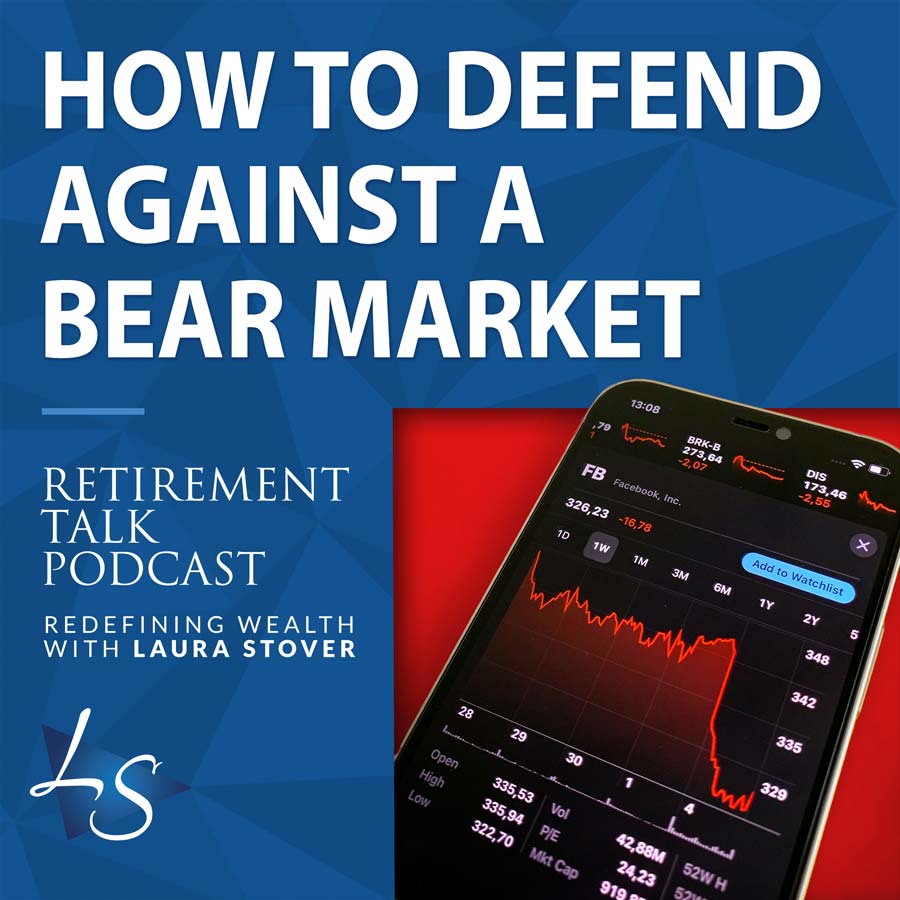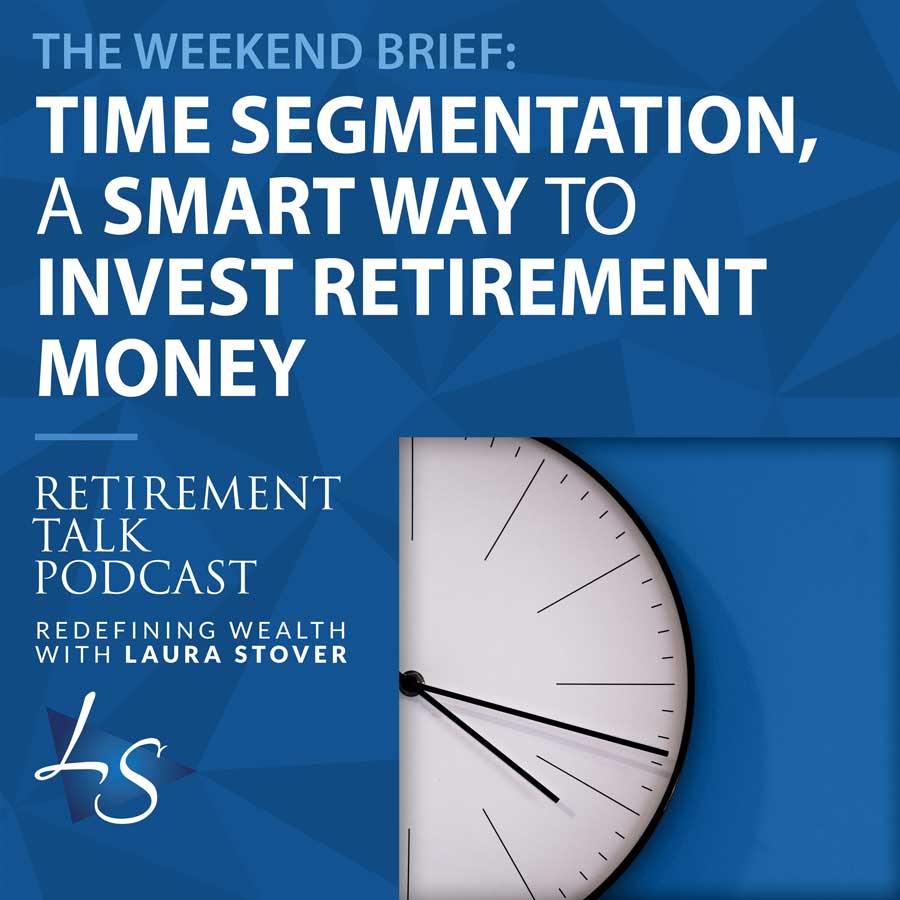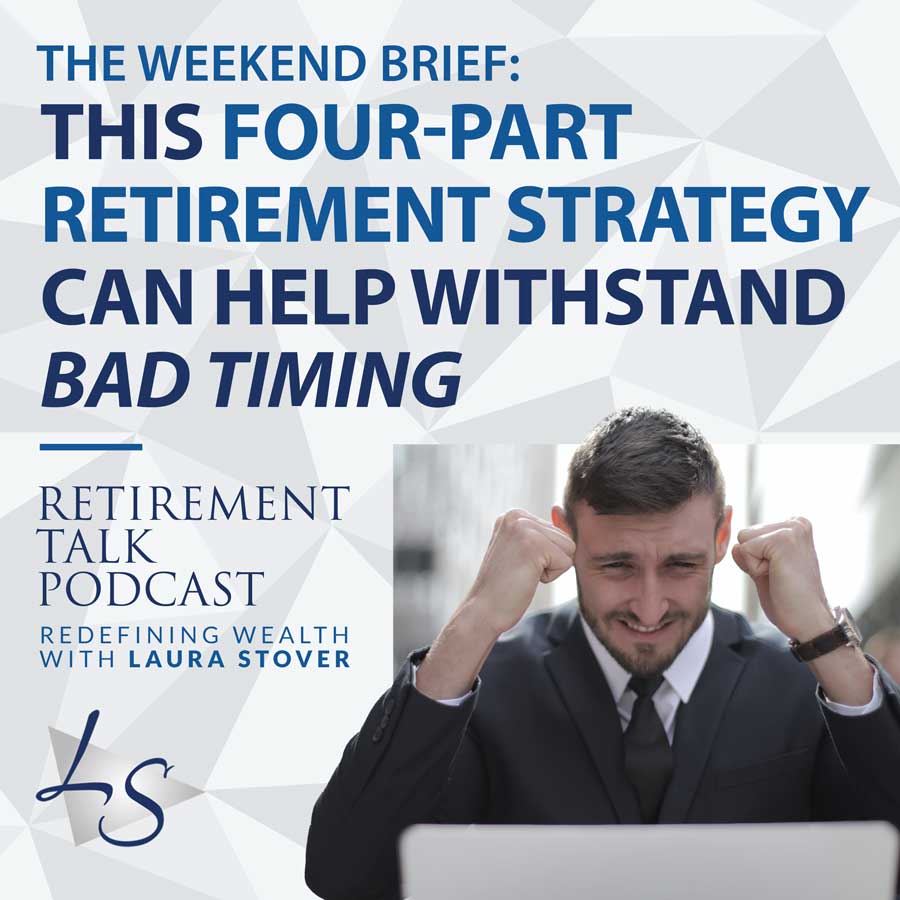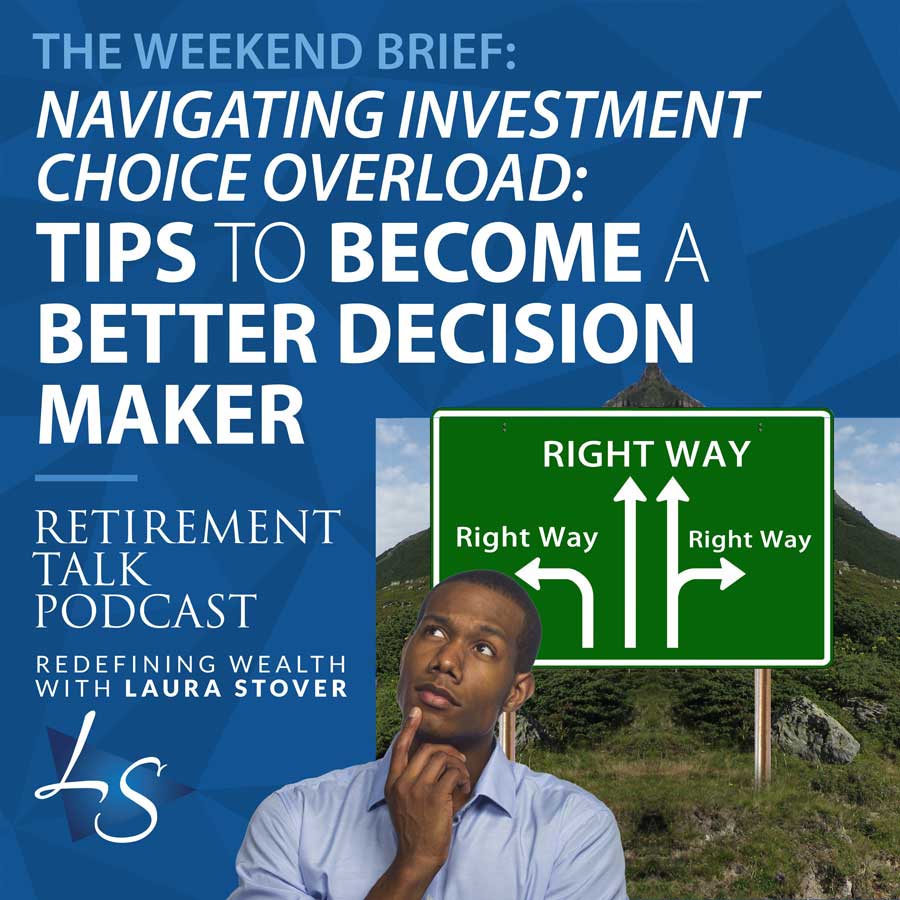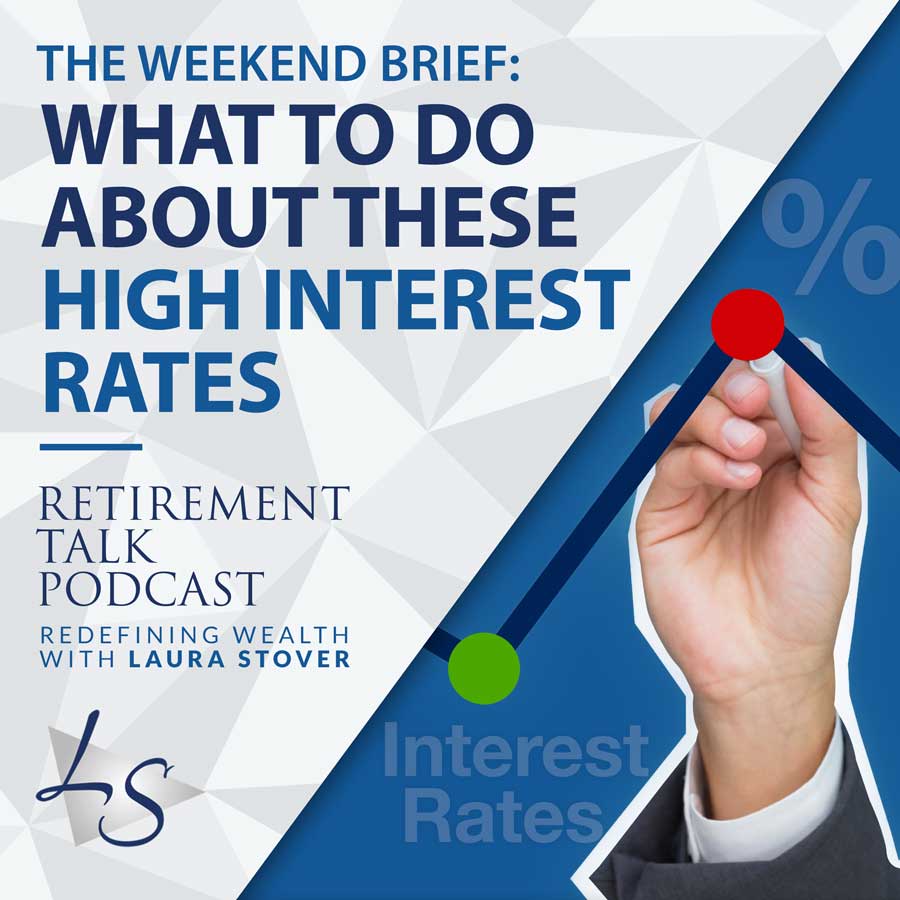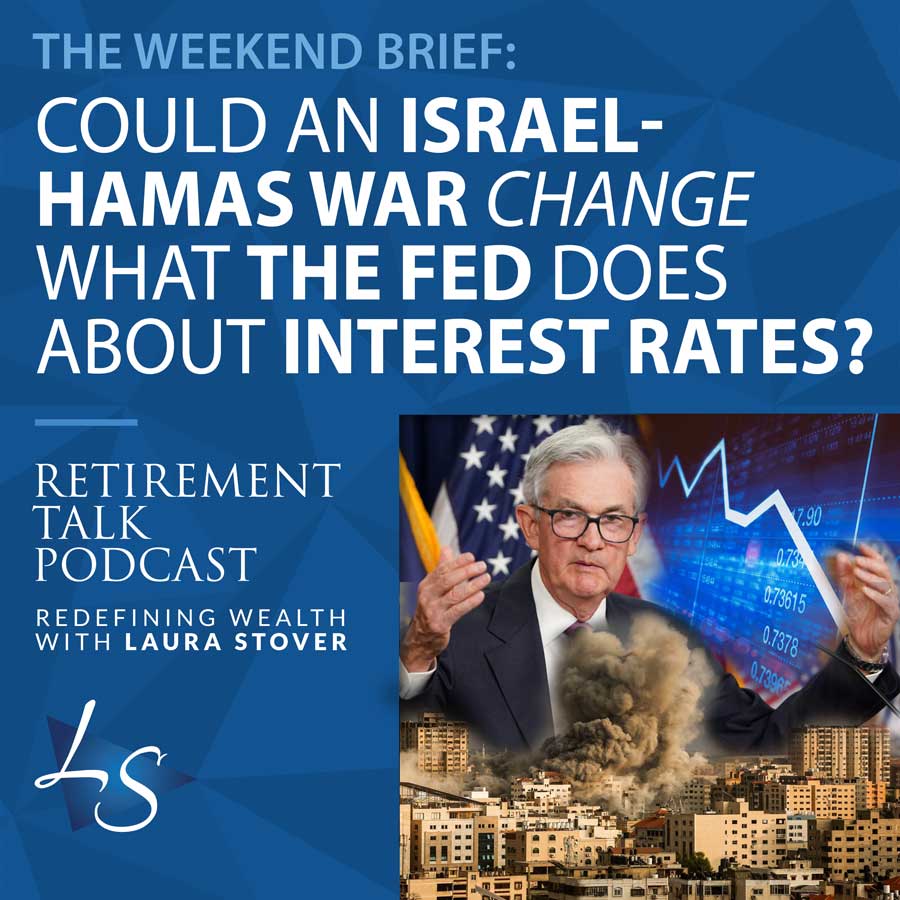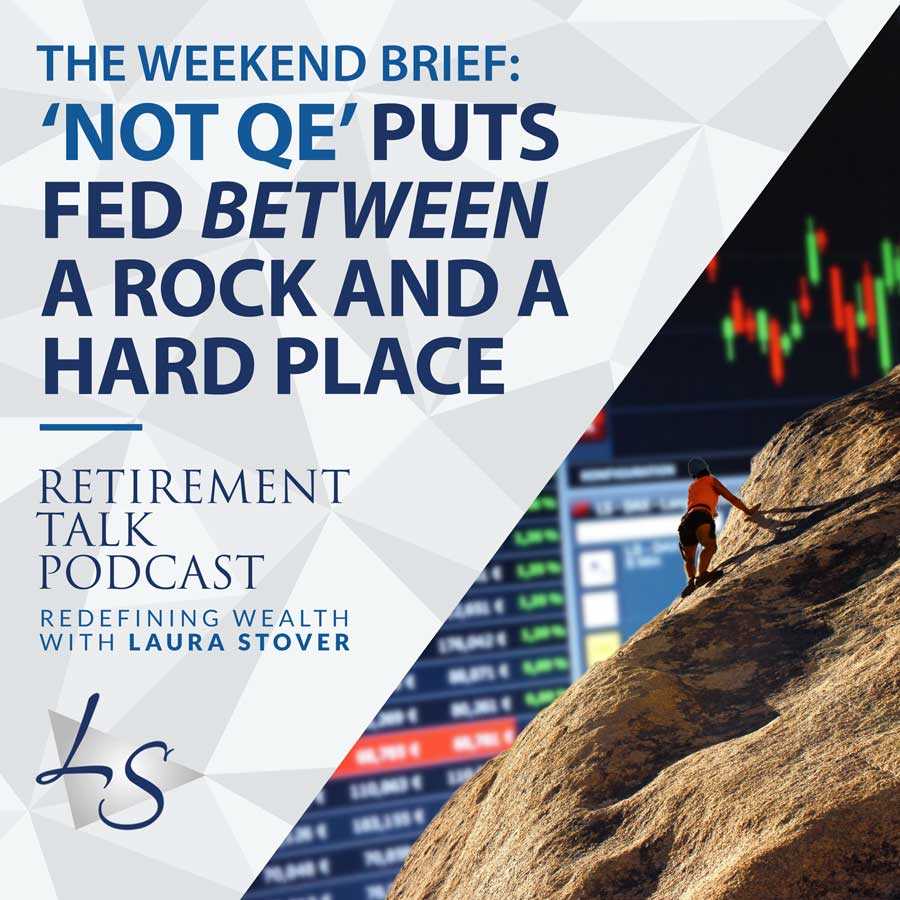As we’ve seen in the past month, volatility is back in the market. Why are we seeing this volatility and what can we do to protect our retirement plan? We’ve seen some robust gains in the past few years, but that might soon be changing. With changes from the Fed, interest rate hikes, and geopolitical tension the market is likely to see more ups and downs.
In most cases, people aren’t great at making decisions under pressure, especially when it’s an emotional choice dealing with their own finances. This is the advantage of working with an advisor. You are working with someone that understands volatility and they can keep you level-headed when the market starts to turn. On today’s episode, we’ll explore ways you can protect yourself against a bear market through diversification, risk management, and more.
Review the article mentioned in today’s show >>
Rate & Review and Subscribe to the Podcast:
https://podcasts.apple.com/us/podcast/retirement-talk-podcast-with-laura-stover/id571347188
Links
Schedule a Review: https://redefiningwealth.info/schedule/
Timestamps (show notes):
1:57 – What’s causing market volatility?
14:36 – Avoid emotional decision making
18:26 – What does it mean to diversify?
23:47 – Don’t get stuck on a loss
28:25 – Manage your risk and plan for opportunity
32:47 – Have an adaptive retirement plan
Listen & Subscribe
Review the Transcript:
Ron Stutts:
Welcome to Retirement Talk, the Redefining Wealth show, your source for financial information, specifically for pre-retirees and retirees. We are here each and every week to help you better navigate during these economic times. We’re here to discuss thoughts and ideas in the field of finance and retirement, as well as discuss trending topics that could impact your bottom line, we will break it all down. These discussions can help you make better informed decisions so you can make better financial choices and live the lifestyle you imagined for retirement. Laura Stover is a registered financial consultant and CEO of LS Wealth Management, as well as founder and owner of LS Tax, a consulting firm. She’s been featured in Forbes, CNBC and The Wall Street Journal. I’m Ron Stutts. Our topic for today is Volatility is Back, How to Protect Your Retirement Account from Kiplinger. Now, here are your hosts, Laura Stover, along with certified financial planner, Michael Wallin.
Laura Stover:
Well, January 2022, started the year like a big snowball effect, Michael, and we’ve had lots of snow across most of the country, but particularly here in the Northwest Ohio area. I think we had anywhere from 18 to 20 inches of snow, and even though I have someone that comes and helps plow my driveway and everything, I think I was out five or six times and I did a whole bottle of Advil. It was hard work. I just want to say hello. Hello. Hello. We did bring some important information. A couple shows back, Mike, I believe is at March 24th or March 12th until we have 12 hours of daylight. Do you remember, was it March 12th?
Michael Wallin:
I don’t remember. It is in March. I’m not certain on what day that was, but I know we are anxiously looking towards March so that we can get a little more sunshine, and fall out just a little bit from what this winter weather has been.
Laura Stover:
Well, I know you have ice in the Nashville area and the year started with a lot of volatility in the financial market. So that is what we want to address today. We’re featuring an article from Kiplinger called Volatility is Back. We want to talk about some of the reasons we’re seeing the volatility, I think that’s important to understand. What you can do as a pre-retiree or retiree or anybody for that matter, what you can do to protect your retirement account, because we’ve enjoyed some robust gains the last couple of years with the market. It’s been very rewarding, but people tend to get really nervous just with small corrections after they’ve been spoiled with such stellar double digit returns for a sustained period of time. It’s been a little bit of a bumpy roller coaster for a variety of reasons. Number one, the Fed, interest rates, geopolitical concerns, just to mention a few.
Laura Stover:
As I stated, we ended 2021 really at nearly an all time high in the S&P 500, but it experienced its worst month since March 2020, this January. We didn’t hit near the correction levels of March 2020, but we certainly saw some wild rides, particularly, Michael, the one Monday when the market declined intraday over 1100 points. That’s why people should not get excited during the intraday trades. There’s a lot of movement in the markets going on and it ended up doing a reversal and actually eked out a small positive the one Monday there in January. We’ve seen a little recovery since then, but I think it’s good practice to take stock during this time. If you found yourself being slightly nervous, or even if you feel you’re doing well. It is always a good practice in my view to take stock of your entire financial plan. What is your emotional barometer? See if you are positioned to endure potentially long periods of lower stock market returns.
Michael Wallin:
Laura, this morning, I spoke to a client that I think kind of summarizes exactly what you’re looking at here. We really went through a sequence of events. Volatility, the market’s going to go up, the market’s going to go down. We’re going to see sideways markets at times. The market is not something that we can tell you in the future exactly what it’s going to do. But what we look at when we’re looking at an overall strategy, we’re looking at a plan with the client, is for them to say, “What amount of my money needs to have a certain amount of risk to return the numbers that we want?” Because there’s going to be events that’s going to happen. You mentioned some of the agenda that has been pressed from the White House. We have seen Jerome Powell come out with the Federal Reserve and spoke both hawkishly and dovish.
Michael Wallin:
That’s what really drove down that January 24th numbers on the S&P that day, because there was some ambiguity that came out. That they sit there and said, “Well, are we going to rapidly try to start increasing the interest rates? Or are we going to do this more dovishly over a long period of time?” Because his words were so uncertain, it left individuals and the market wondering what’s going to happen, and we saw a major correction and that correction happened throughout. As you mentioned, we would come back up that then we would bob back under the water. Then, before the end of the day, we would find that there was some stabilizing in the market and we would come back above certain thresholds. But for our organization, we were very close to triggering looking at some of our algorithms to taking our clients from a risk on to a risk off position, simply because of that draw down.
Michael Wallin:
But again, the methodology worked just like it was supposed to because we stayed fully invested. We have seen about a two and a half percent increase back in the market this week. But as I told the client this morning, when you’re investing for the long term, you cannot be looking at what happens in a week to make your long term decisions. That you need to have a good strategy but if you find that those dips in the market causes you a little bit too much heartburn, you may have to dial it back and realize your risk tolerance level is not what you thought it was.
Laura Stover:
Well, isn’t that the truth. I think that wild intraday trading with the huge swings is more of an acid reflux thing, more than heartburn, because it’s just all over the place. The Fed, honestly, he was very ambiguous, as you stated. We’ve heard fairly conclusively, but it’s always subject to change. I mean, the bottom line, I think he’s a little uncertain with what he may or may not do, and it depends on economic conditions. So that’s essentially what his consensus was, and he cannot dictate with absolute certainty. A lot of it depends on job growth. It depends on some of these supply chain and bottleneck issues that are causing some aspect of the inflationary environment that we are in, passing over. Was it set 7-7.1% in December of 2021? So we’re seeing oil prices, $90 a barrel now, and that’s about the highest since 2014.
Laura Stover:
That sector incidentally has one of the few sectors that’s done very, very well recently. So people’s perceptions. It always comes down to perception, and you stated it exactly right. I think Warren Buffet has made, he talks about volatility and essentially if you can’t stomach it, you shouldn’t be investing at all, is the bottom line in terms of what Mr. Buffet has to say at about that. So short term intraday volatility is normal. It was long overdue and people’s perceptions are indeed what it comes down to Alliance, incidentally did a market perceptions study, Michael. They found that people are more worried that a big market crash is on the horizon than they’ve been all year.
Laura Stover:
So at the same time, nearly seven in 10 people, that’s about 69% say they are worried that the increase in COVID infections will cause another recession. So those concerns are really partially to blame and really where the impact of the market volatility on retirement security that worry that people have over inflation being very high, many believe is going to get at worse and affect their retirement plans. The study found that 78% of Americans expect inflation to get worse over the next year, and 69% think that it’s negatively going to impact their purchase power in the coming months. That’s fairly significant.
Michael Wallin:
Yeah. Some of those things that you’re looking at there, we see that negative side. I think it’s partly part of the American persona today is to always as good as things have been, we’re looking for that other foot to fall. But we had some great news came out this morning. One of the reasons that I’m not looking at a recession is that we just saw the 10 year yield come up to the highest point it’s been during the pandemic. Typically a recession has an inverted yield curve, and we are seeing the 10 year yield on the treasuries, very strong are increasing at this point. Another thing is we have jobs reports. Part of what happened on January 24th was that we were sitting there looking at what the volatility of happening in the market. We looked at what Jerome Powell was saying, but we also was hearing out of the White House this kind of the softening of the effect of where the White House was saying they didn’t expect the jobs report for this month to look good.
Michael Wallin:
They were saying, look at about 125,000 new jobs being created. Well, the report this morning came out with 467,000 new jobs were created, and that is tremendous. That’s a four times greater impact than what we were really expecting from what the White House was telling us. So there’s positive, and I think it’s so important that you’re not getting the news or off of one of the medias, whether it’s a TV site or you’re reading an article or you’re reading these things. You have to really look at the data sets and the data is not supporting a recession. The data is not supporting a major correction because we also have a trillion dollars that we have not released out of the treasury. We all saw the impact in 2021 of what happened when we released all of that extra capital into the market. We saw the market respond very favorably.
Michael Wallin:
We still have a trillion dollars sitting there. Many people may be familiar with Brian Wesbury. Brian Wesbury was doing an analysis the other day. He’s a chief economist for First Trust portfolios, and he was not being so bullish to think that the market was going to get to this level. But if you do the mathematics behind it, the market could expand all the way up to 6,100, where we are today and we’re sitting at about 44. As of recording today, we’re sitting in that 4,400 to 4,500 corridor on the S&P 500. So we have opportunity to grow. But the key thing is, like you said, look at your barometer. Don’t be so knee jerk reaction to move so quickly out of the market, because if you do, and then you try to get back in the market. That is that timing of the market that is emotionally driven, and that’s typically going to reduce a per person’s returns by two to 300 basis points a year. Compound that over a 15, 20 year period for your retirement, and that is substantial loss because individuals are being emotional.
Laura Stover:
If you’re very fearful at those times, then I think you need to, again, take a look at your barometer and your risk capacity. What amount of risk do you need to have, number one, to be successful? We’ve spoken about this on past shows. What do you need? What is your capacity for risk? What is your attitude, and if you are getting all in a tizzy every time the market has a bit of volatility? Because it’s going to happen. If you’re that nervous every time that happens, then I think you really need to reevaluate what you’re doing to begin with in the structure of your portfolio overall. Now, as you stated, Michael, yeah, the news headlines, people and individual investors, they kind of like a little bit clearer direction. Even if we managed to score a magical newspaper from a year in the future, we wouldn’t necessarily be able to invest well off the back of it because we’d need the money pages is definitely not just the news.
Laura Stover:
So some of the tips that we want to cover here on the show today, five in particular. Ways that you can cope with the ups, the downs and be better prepared when volatility does rare its ugly head. First one here, Mike, is don’t feed the beast. I like that verbiage. One of the things that we aren’t very good at is making decisions under pressure. I don’t think, some people do and have to be able to make decisions under pressure. I would say as advisors, certified fund analysts, people tend in hospital emergency rooms, you have someone coming in from a catastrophic accident. They follow protocols, they follow procedures, they follow rules to deal with crisis, and that’s the advantage of working with professional money management. Because fear brings excitement and anxiety, and a host of other emotions into the investing process at a time when they’re not welcome. If you look before 2022 gives our pulses cause to race, remember volatility really is a normal part of investing.
Michael Wallin:
Yeah. It’s a very interesting you say that because as clients come in, it’s often a phrase that they’ll say is, “Oh, I don’t want to see my portfolio do like it did in 2001 or 2002 or 2008,” and my question to them is, are you using the same strategy now? Have you not made any adjustments to your philosophy? Are you exposing yourself to the same kind of planning or lack of planning that you had at that time? Have you not made any behavioral changes? Because where we are today, you should not be feeding the beast. You should not have all of your assets in one bucket of money, looking at it from one approach that every dollar you have is being viewed as this is my money I’m depended up on this year or next year or the next year. You have got to tranche your money set, operate your money into different buckets.
Michael Wallin:
That way, when the market has volatility, it doesn’t affect you. Because if you’ve got money you’re going to be dependent upon for zero to three years. There should be very limited amount of volatility on that money. The counter of that is if you’ve got a bucket of money you’re not going to use for 15 years, well, you shouldn’t be concerned about whether the market goes up or down, because you’re not going to be dependent upon it for a long period of time. It’s the same thing when you were working 15 years from retirement, you probably weren’t sitting there worrying every day over what your 401k was doing. I think some of those emotional dynamics is to take a picture of what the market does over a longer period of time and say, has the market moved from bottom left to upper right over a longer period of time?
Michael Wallin:
If it’s consistently doing that, you should embed some of that philosophy in your approach. Don’t feed the beast. Don’t feed your fear, and be so concerned that you’re losing value. Like I told the client this morning, Laura, I said, “You haven’t sold off any shares. You own the same amount of shares. You’ve not lost any money. All you have is, right now, you’ve had a contraction on the price and when it expands back out, you’re going to have the same number of shares. And you’re either going to have the same value or it could be more, but it’s about trusting the process.
Laura Stover:
Absolutely. And not reacting rashly, take a step back, take a chill pill, I guess is the old term there, right? Does that date me in the eighties or nineties? Remember, this is what we all signed up for and help you to understand that now means you are less likely to rush into emotional decisions later. That’s really the key. Now, the next one here diversified, this certainly a overuse sentiment. Because people, I think don’t really understand what it means. How do you separate out your safe assets from your risk assets is really how I define diversification, and people really confuse diversification I believe with asset allocation. Asset allocations immensely important, it’s like 92.6%. I remember the books that I read. I remember numbers, 92.6% of how well your portfolio is allocated really is going to determine how well it does over time. You have to be diligent in that.
Laura Stover:
That’s why it’s important to have, in my view, money mangers responsible for those things. Because they provide all of the very deep layers of research, they have intellectual property in terms of how they go risk off, make an exit and rules to reenter and come back in. Your 401k plan is completely different than that type of money management. The idea when you’re investing in your 401k, I did a good show on this last week. I said that it was really a disaster. It was never intended to be the sole source of retirement income for individuals. You know what the elimination of pensions and set, when you’re dollar cost averaging and you have money going in. Yes. When things decline, you’re buying more share prices and that’s great, but you cannot continue with that same investment philosophy. Now, if you are nearing or in retirement, it becomes a whole different agenda in terms of dollars and percentages.
Laura Stover:
You also don’t want to hold investments. You want investments across different asset classes. That’s part of diversification. Understanding fixed income has many different cousins. It’s not all high grade corporate bonds. There’s many other types of asset classes that can help with yield and provide diversification. There can be cash. There can be tips. There can be real estate. There’s options based things that provide hedges in people’s portfolio. There’s structured notes. There is a whole tool chest of vehicles available, and being able to diversify across industries and national economies by holding investments in global facing companies or multiple companies in different countries and categories. There is many flavors of risk, but to understand diversification is best to focus on, I think specific versus systemic risk.
Laura Stover:
Anyhow, we don’t want to get too deep in the woods here with economics, but reducing your exposure to any particular stock or industry. You reduce your vulnerability to that unpredictability with problems that can occur and that certain companies can face. That’s really, really important. I still see people today very concentrated, even if they have a larger size portfolio, they really are taking much more risk than what they realize and what they really have to take.
Michael Wallin:
They’re still individuals that we are seeing that are invested into emerging markets. A lot of those emerging markets have had the shutdowns due to COVID. They can’t get goods and services imported in that their consumers need out of their citizens, that they need to have their quality of life. When you’re starting to look at that, I believe that you want to look at the countries that are opening up. But when you do have a risk, such as what COVID did with shutting down economies, there’s still people that are invested. Their advisors have never modified their positions, changed them out of it and that is an anchor dragging down their returns on their portfolio. Simply because those areas are being impacted due to the COVID dynamic. You talk about the United States having a supply chain issue. Some of these other countries are even greater impacted because of importing goods and services in.
Laura Stover:
Again, proper diversification, we’re spending a little more time on this one because I think it’s probably the most important of all of these five things people can do. Again, separating out assets. It’s not just, if you put more in safe money, where there’s more safety, what I would call a contractual guarantee, then you’re going to have a lower return. So there’s a fine balance. Markowitz won the Nobel Prize. He figured out that 50% bonds, 50% stocks has about the same risk as bonds but higher return, bonds can also be risky. A lot of people equate them as safe. They’re maybe safer, but not completely safe. So part of this overall diversification for income is what you really need to solve for, and then segmenting assets. That can make absolute sense and that is why having a written income plan, understanding these decisions through a process.
Laura Stover:
That’s why I created the Redefining Wealth Process. Also, not getting too distraught or sunk into. There’s a behavioral finance here, a loss, a good investor’s going to try to measure no matter what’s happening around the world in their portfolio, you don’t want to be sunk into the cost of the loss. Oh, I can’t do anything now. I’ve got to wait for it to come back. I mean, I hear that on the flip side and that sometimes can be an anchoring position. If it’s a dead horse, so to speak in the portfolio, sometimes you have to cut a short term loss if it makes sense to do so and make a change for the long picture overview.
Michael Wallin:
Yeah. Wayne Gretzky, famous hockey player said, “Skate to where the puck is going to be.” It’s a misnomer to think that, well, I went down, the stock price went down and I’ve got to wait until it comes back to its all time high before I can change. Well, if there’s another stock or another company, another position, another strategy that could make you have a quicker return on your money, then pivot. Because there’s no guarantees that any company is ever going to make it back to its all time high. As we’re recording this today, we’re seeing that Meta is having a major issue. Facebook is being impacted.
Laura Stover:
I hate that name. Why do they name it meta?
Michael Wallin:
We’ll cover that in another show. But Meta, it’s a technology term as it deals with websites and how they capture information about a person. Those are those little meta files that’s out on the internet that were there constantly capturing information about you.
Laura Stover:
We’re talking about Facebook for anyone that’s not familiar with Meta, it is Facebook.
Michael Wallin:
Yeah. There’s a major correction in that. So as we look at this, Laura, one of the things I think that you brought up that is so powerful here is as we look at the allocation, we look at where people are putting their money. But it goes back to not discounting any product right off the bat, have a comprehensive plan, a strategy that puts it together with an open mind of all financial products. Then, using those products that make the most sense to give you the highest probability of success is really that diversification. But I think diversification first comes with open mindedness on what are the options that’ll give me the highest probability.
Laura Stover:
Well, keeping those behavior economics in check, do not let your emotions be held ransom, so to speak. Having a balance on this, having a defined process and understanding the purpose of your portfolio, that is the groundwork that number one has to be achieved. Making sure there’s a coordination between income and tax and healthcare planning, estate planning and investment planning and enough liquidity in the portfolio. When it’s all tied in together, those are the key risk in one way shape or another that we’re all going to face. That’s the whole jigsaw puzzle to manage in retirement. You’re listening to Retirement Talk, the Redefining Well show with Laura Stover and Michael Wallin.
Ron Stutts:
You’re listening to Retirement Talk with your host, Laura Stover and Michael Wallin. To learn more about how we can help you redefine your wealth. Receive a complimentary copy of our guide on How to Defend Against the Bear Market, email [email protected], that’s [email protected]. If you want to make sure you’re on the right financial track and take this a step further, go to redefiningwealth.info, schedule a 15 minute strategy review to talk more about your unique situation, redefiningwealth.info. You’ll also be able to get access to today’s show notes. Now, back Retirement Talk, the Redefining Wealth show with your host, Laura Stover.
Laura Stover:
So we’re talking about volatility, some things that you can do to put your risk gauge and perspective, and how to navigate your retirement portfolio during a little bit of a volatile year. 10% corrections are not uncommon. It was long overdue. They’re common every 15 to 19 months, and many of our research team does a lot of studies on this. A 10% correction is really nothing to get in a panic over, from our perspective, if you’ve aligned your portfolio properly to begin with. So managing risk is number four here, by managing risk, you can plan for opportunity, and that’s a good chance to finally build a position for the long term. A lot of price conscious, professional investors have a wishlist ready so that they can access any downturn, depress prices. They can quickly decide if it’s time to invest in something else or walk away.
Laura Stover:
It also applies in terms of stocks that you currently hold as well. Let’s go just a little deeper on this. We’re in favor of blending strategic and tactical management, diversifying by segmenting out this safe assets that you need for income with segmented assets that you have to have. It’s essential for growth and long term growth through the duration that one’s going to be in retirement. People are living much, much longer. If you haven’t look lately, things are costing a lot more money. As the old adage goes, not putting all of your eggs in one basket, not taking more risk than what’s necessary. It’s about risk adjusted return. Being smart with the risk that you’re taking in the portfolio, that’s a little bit to unpack. We haven’t said that word for a while, but we like a variety of things when it comes to the management style.
Laura Stover:
I like a lot of the concentrated stock portfolios. If you are someone looking for a lot of growth and have a long time horizon, or you have Roth IRAs to fund. Let’s talk about some of those focus beta, concentrated stock portfolios that can, I mean, those companies are going to do well. There’s a big story, do you want growth? Do you want value? Having the right mix is really, really important. Just like a chocolate chip cookie, right? It’s got to taste perfect. Then the ingredients have to be just right, I’m not a baker. So I got myself in trouble with this analogy. But having the right balance in the portfolio, being able to taper some of those concentrated stock portfolios with maybe taking risk off the table at the same time, that’s where we’re going with a blended approach.
Michael Wallin:
Yeah. A lot of those growth companies that we’re looking out that have performed exceptional over the years, and growth has by far outperformed value over this last 10 years. But that’s where you’re also going to get the greatest potential for negative volatility. So one of the things that as we look at volatility, volatility is not a negative or a bad thing per se. You want volatility because volatility is actually where you see opportunities and you get growth on it. It doesn’t always mean something negative. You’re taking advantage of volatility when you’re seeing the gains happening in your portfolio. But value, a value is a nice core platform to be in because if you’ve got a basket of say 30 to 50 stocks and they are good dividend paying stocks, you are receiving a share of that company’s profits being spread back out to each of its equity owners.
Michael Wallin:
When that happens, you’re able to kind of buffer some of that downdraft when you see that normal volatility, you see that drawback of that five, six, 7%. You’re seeing if a portfolio’s yielding you three, 3.5%, you’re not really seeing the overall impact. If that was a growth stock you would absorb all of the loss. So those are some things that I like to see, plus value based companies are companies that have been around much longer, they’re more established, they own market share. Where you’re seeing opportunities and growth there is where they’re either increasing on the service or the products that they’re offering to the consumer. But consumers have already shown confidence in those companies. So those are more of when you’re looking at investing, diversifying, as you’re saying inside of it. Look at what do you have in a value basket. Look at what you have in the growth basket. But if it’s growth, tilt that more towards those latter years where you’ve got a longer time for recovery.
Laura Stover:
As an investor, you should expect these bumps in the road, and spreading viruses, that’s very scary. Market fluctuation isn’t necessarily all negative. Volatility isn’t just markets dropping, its movement. Markets can and have moved down, but volatility means they can move up too. Again, it’s about having the right plan in place from the very get go, and adapting your plan and adjusting it, not just having a plan a few years ago and never adapting or making changes or adjusting. That’s why we want the Redefining Wealth Process, making sure that we’re adaptive with that plan and having a structure in place so that all parts of the plan are working together. You have to interrogate your stocks now. Now is a great time to evaluate your barometer. Remember, Warren Buffet, he’s always advocated that if you aren’t ready to see your portfolio drop, now he says 50%.
Laura Stover:
We like to keep things to maybe 10 or 15% on moneys you’re not going to be dependent upon today. But if you’re, according to Mr. Buffet, not ready to invest, if you’re not prepared to see some market movement. So you have to be able to not panic, write yourself a clear, concise reminder and a conversion of what you want and take a good look at what you’re comfortable with and really get a second opinion. You hear this on a lot of shows a lot of times, but truly, if it makes you a little nervous or if you’re wondering a little bit about some of the stuff that Michael and I are talking about. Go to redefiningwealth.info, take advantage of a 15 minute strategy review. You can also email info, I-N-F-O, [email protected], request the Volatility Bear Market handout that I have, that you can read up on that if you have a 401k and you may find some of the information helpful.
Ron Stutts:
Take advantage of a complimentary portfolio stress test, find out how much risk you have in your portfolio. Determine the appropriate number you need to be successful. Schedule a portfolio stress test by going to redefiningwealth.info, click Review. You can have this information in the comfort of your own home. Redefining Wealth is registered trademark of LS Wealth Management. Take advantage of a complimentary plan. Know where you stand regardless of the market. Walk through the Redefining Wealth Process and have a clear picture of the key risk you likely will face and achieve a deeper understanding of how to properly plan for these risks with the Redefining Wealth framework. Schedule a strategy session now by going to redefiningwealth.info and click Schedule. Redefining Wealth is a registered trademark of LS Wealth Management. Investing involves risk, including the potential loss of principle. Any references to protection, safety or lifetime income generally referred to fixed insurance products, never securities or investments.
Ron Stutts:
Insurance guarantees are backed by the financial strength and claims paying abilities of the issuing carrier. This show is intended for informational purposes only. It is not intended to use as the sole basis for a financial decisions nor should it be construed as advice designed to meet the particular needs of an individual situation. LS Wealth Management LLC is not permitted to offer and no statement made during this show shall constitute tax or legal advice. Our firm is not affiliated with or endorsed by the US government or any governmental agency. The information and opinions contained here and provided by third parties have been obtained from sources believed to be reliable, but accuracy and completeness cannot be guaranteed by LS Wealth Management LLC. Investment advisory services offered through Optimize Advisory services and SEC registered investment advisor, LS Wealth Management is a separate entity.

